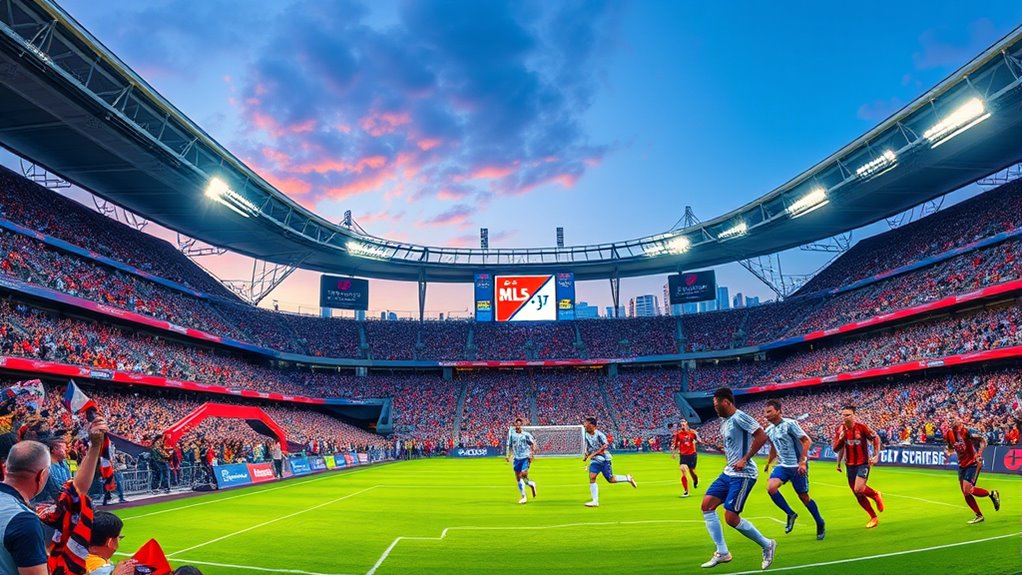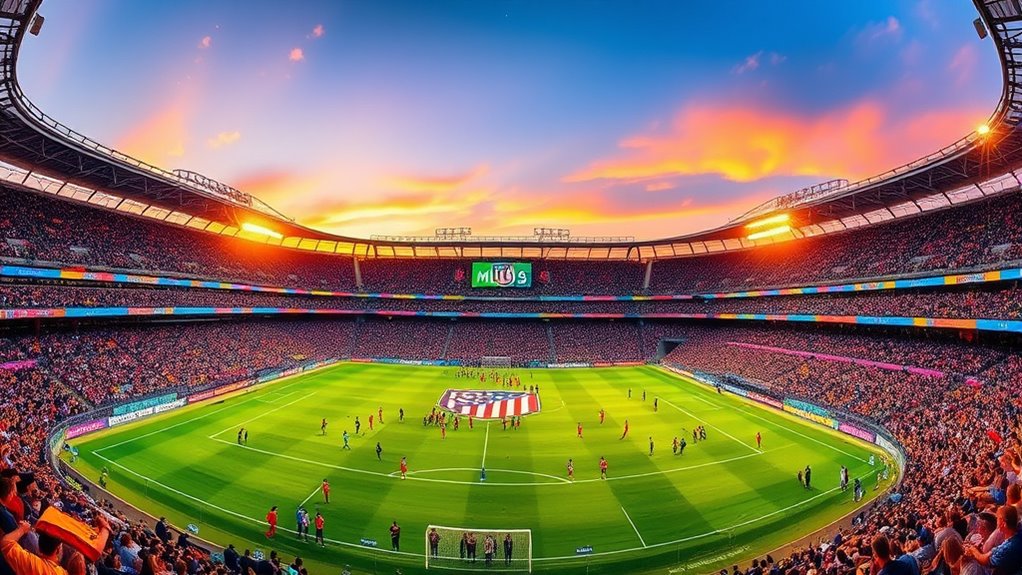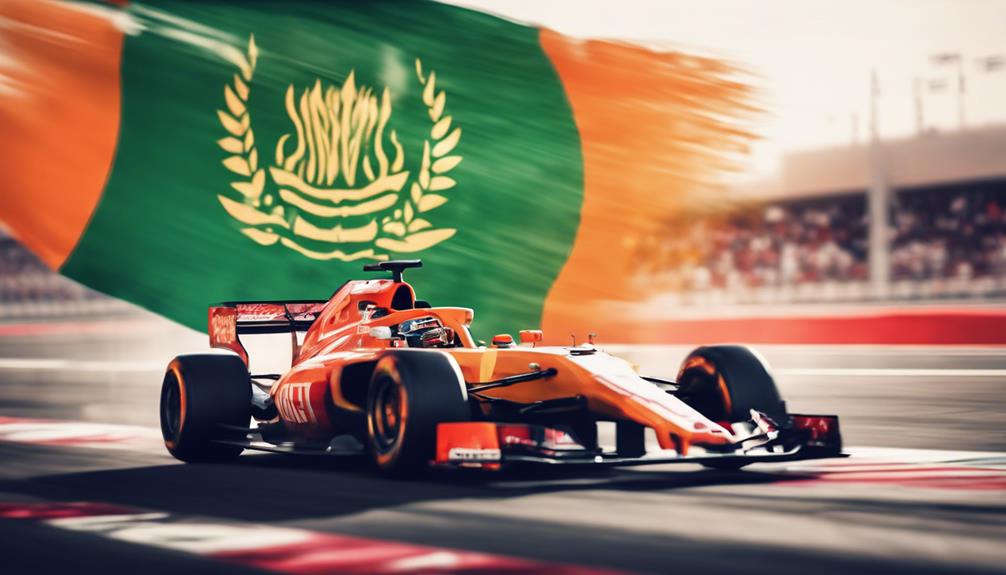By 2025, Major League Soccer is showing strong growth through youth development, international partnerships, and boosted global recognition. You’ll see more homegrown players, exciting matches, and collaborative projects with clubs worldwide. However, challenges remain in maintaining high competition levels and expanding its fan base. If you want to understand how the league plans to keep evolving and overcoming hurdles, there’s plenty more to explore.
Key Takeaways
- Youth development initiatives will continue to produce higher-quality domestic players, boosting league competitiveness and international recognition.
- International partnerships are expected to expand, enhancing exposure to diverse playing styles and attracting global talent.
- Challenges may arise in balancing rapid growth with sustainable financial and infrastructural development.
- Fan engagement and community outreach efforts will deepen, fostering stronger supporter bases and local loyalty.
- The league’s global profile will rise, increasing international viewership, sponsorship, and co-hosted tournaments.

What can fans expect from Major League Soccer in 2025? As the league continues to evolve, you’ll notice a stronger emphasis on youth development and international partnerships. These areas are central to MLS’s strategy to elevate the level of play, attract global attention, and build a sustainable future. Youth development programs are becoming more sophisticated, with clubs investing heavily in academies and training facilities. This focus means you’ll see more homegrown players making their way into first teams, showcasing local talent and fostering a sense of community loyalty. MLS is also forging international partnerships with clubs and leagues across the globe, which helps create pathways for player exchanges, friendly matches, and shared expertise. These collaborations not only enhance the quality of competition but also boost the league’s profile on the world stage.
With youth development, MLS is working to identify and nurture young players early, providing them with professional-grade coaching and resources that were once scarce in American soccer. This investment results in a pipeline of talented athletes who can compete at top levels, both domestically and internationally. As a fan, you’ll likely see more young stars making headlines, contributing to the league’s competitive edge and *engrossing* your attention. These initiatives also serve to improve the overall standard of play, making matches more exciting and unpredictable. The league’s push for youth development is a clear sign that MLS aims to become a breeding ground for future international stars. Additionally, the increased focus on community outreach and fan engagement helps build a loyal and passionate supporter base, strengthening the league’s presence at the local level.
Meanwhile, international partnerships bring fresh ideas, technical expertise, and access to diverse playing styles. These alliances often involve exchange programs, joint ventures, and co-hosted tournaments, which expose players and coaches to different cultures and tactical approaches. Such collaborations help MLS clubs adopt innovative training methods and enhance their scouting networks globally. As a fan, you might notice an increase in high-profile international players and coaches joining MLS teams, raising the league’s competitive level and marketability. These partnerships also foster a broader fan base, as supporters from partner countries follow the league more closely.
Frequently Asked Questions
How Will MLS Address Rising Player Salaries in 2025?
In 2025, MLS will address rising player salaries by adjusting player salary caps to control costs while still attracting talent. You’ll see teams focus on strategic contract negotiations, balancing competitive salaries with financial sustainability. MLS might also explore incentives and performance-based bonuses, guaranteeing players are rewarded fairly without overspending. This approach helps maintain league growth, keeps teams financially healthy, and ensures your favorite players stay competitive and motivated.
What New Markets Are MLS Considering for Expansion?
You’ll find MLS considering international venues like Mexico City and Vancouver, aiming to expand its reach globally. Additionally, franchise acquisitions in markets such as Charlotte and Sacramento showcase the league’s strategic growth. Notably, MLS has grown by over 50% in international fans in the last two years, emphasizing its global appeal. These moves help build stronger international connections and diversify its fan base for future success.
How Is MLS Planning to Improve Youth Development Programs?
MLS is actively enhancing youth development by investing in youth academies and expanding scouting networks. You’ll see clubs focusing on developing local talent from a young age through dedicated academies that provide high-level training and exposure. Additionally, MLS is strengthening scouting networks to identify promising players early, ensuring they’re nurtured within professional environments. These efforts aim to create a sustainable pipeline of homegrown talent, improving the league’s overall quality and competitiveness.
What Technological Innovations Are Being Integrated Into MLS Matches?
You’ll notice MLS is integrating cutting-edge technology like Virtual Reality for training and fan engagement, making the experience more immersive. AI referees are also being introduced to improve decision accuracy during matches, reducing human error. These innovations aim to enhance the game’s fairness and excitement, keeping fans engaged and involved. As a result, MLS is embracing technology to revolutionize the soccer experience for players, officials, and supporters alike.
How Will MLS Tackle Fan Engagement Amid Changing Entertainment Trends?
You’ll see MLS ramp up fan engagement by integrating virtual reality experiences, allowing you to immerse yourself in matches from anywhere. They also leverage social media to connect fans, share exclusive content, and foster community. By adopting these technologies, MLS keeps fans engaged amid changing entertainment trends, making attending matches or following your team more interactive and personalized. This approach guarantees you remain connected, excited, and involved in the soccer experience.
Conclusion
As you imagine MLS in 2025, envision packed stadiums echoing with cheers, new teams expanding the league’s reach, and fans fueling a growing soccer culture. While challenges like infrastructure and competition remain, your passion and support can turn these obstacles into opportunities. Just like a seed that blossoms into a vibrant tree, MLS’s future depends on your enthusiasm. Together, you’ll shape a brighter, more exciting soccer landscape that thrives for generations to come.










